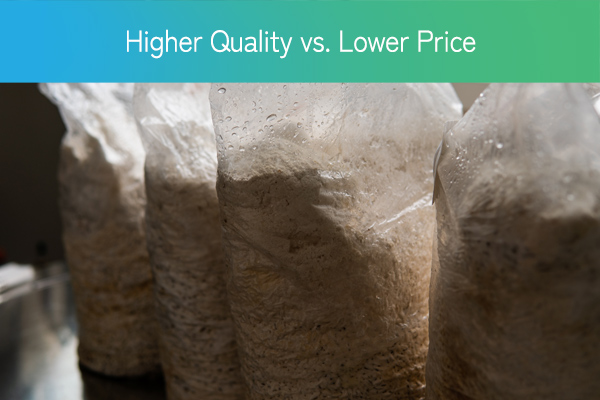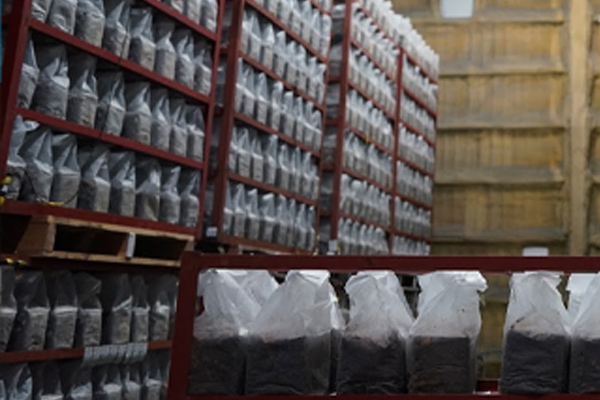Why Sakato?
Revisiting our partnership with Sakato SangyoIn each issue of the Japanese Exotic Mushroom Journal published by my company, SALAI International Japan over the past few years, I have included a write-up, unchanging about Sakato Sangyo, the maker of Sakato bags for mushroom cultivation. Sakato Sangyo have been a critical partner to bringing Japanese cultivation technology and standards to a broader Western market, and this time, I would like to go into more detail about what makes Sakato unique and what is special about Sakato bags that makes them stand out above all other options in the mushroom farming sector.The two big factors that make Sakato Sangyo stand out are: flexibility and quality control.I. FlexibilitySakato Sangyo has one huge advantage over any firm working in this extremely small and niche market: they have their own inflation machines and produce their own film. Almost every other major player on the market is purchasing plastic film and then processing the film into mushroom cultivation bags, which is mainly down to the proper attachment of a filter, an excellent seal at the bottom of the bag, and maintaining extreme uniformity in the size and volume of the bag.What this means is that Sakato Sangyo can adjust and experiment regularly, producing custom in-house blends of plastic designed for the needs of the mushroom industry. This has been very important especially as regards emerging exotic mushroom farms in Western markets, which had very different practices and very different needs than in Japan, particularly when it comes to clear polypropylene based cultivation bags. It is not an exaggeration to say that without Sakato’s ability to test new materials and also provide new products, that much of the growth we have seen in the Western market, especially in North America, would not have been possible.As seen in the pictures below, Sakato Sangyo utilizes a dozen different plastic components in differing combinations and proportions depending on the bag type. This also means they have a very stable product and have full control. Whereas a filter bag maker that relies on manufactured film is at the mercy of a supplier who may make minor changes to their formulation based on cost or availability, Sakato controls the materials that go into each bag. Mushroom cultivation bags in addition account for a fraction of a percent of the film industry; even for the few suppliers that produce the film, it amounts to no more than a few percent of their total production, and, as Sakato’s CEO Kouta Obuchi told me, for the sake of production efficiency and overall profitability, most of those producers would prefer to eliminate mushroom cultivation bags if possible.Therefore, for Sakato Sangyo, controlling the production is a security measure, as if a plastic film maker suddenly stopped production, there could be a months-long delay in filter bag production and the new bags, even if placed for the same material, could have different properties depending on the production process and sourcing of the raw materials. In this way, flexibility also intersects with Sakato’s desire for control over their product, and for stability and consistency, as mushroom farmers across the world demand.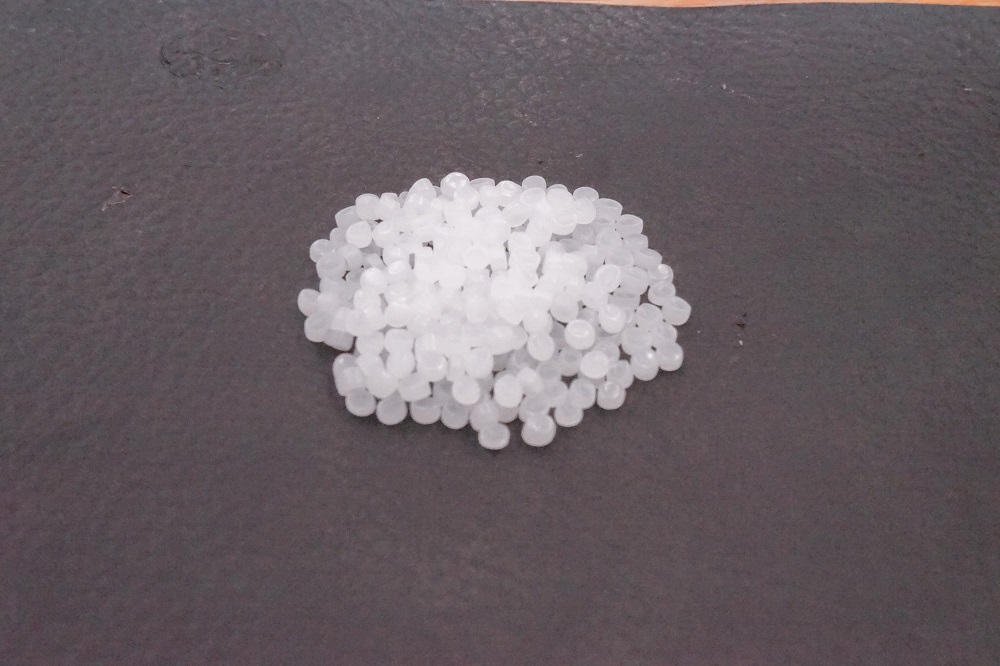
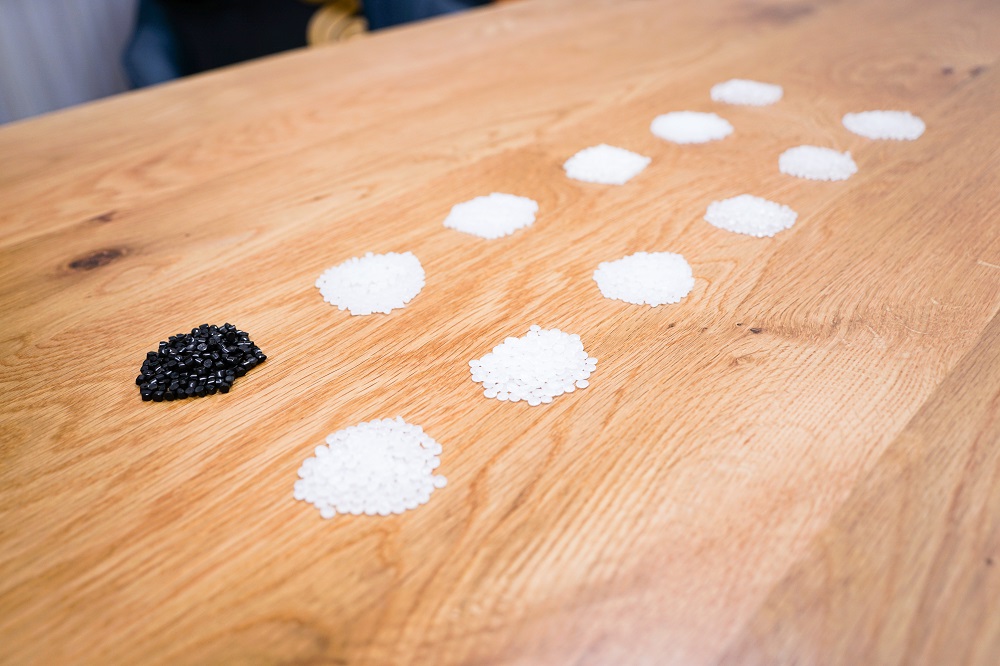 A close up of some of the plastic granules used by Sakato.An array of all the different plastic components Sakato uses, in different combinations and proportions depending on the bag type.
A close up of some of the plastic granules used by Sakato.An array of all the different plastic components Sakato uses, in different combinations and proportions depending on the bag type.- II. Quality ControlI’ve gone over how Sakato maintains strict control over their raw ingredients, but producing their own film with their own inflation machines also enables them to keep a constant watch on the production of film. Unlike plastic bags for, say groceries or other commercial packaging, mushroom cultivation bags are both thicker, tougher, have a higher melting point and have to adhere to a very narrow margin of error in terms of bag thickness and dimensions. Sakato does not simply have to trust that their film manufacturer had no oversights during production, their staff is constantly inspecting and tweaking the process.The film Sakato uses in its production is tricky, and there are slightly different adjustments and processes depending on the type of plastic, PP or PE and bag size or plastic composition as well. This is all done by hand, including overseeing the inflation machines which are highly sensitive to tiny changes in ambient air temperature and humidity, air flow and other variables. Workers even patrol the factory floor taking hourly measurements of random sample bags, confirming the proper bag thickness down to a thousandth of a millimeter on eight different points on a single bag. After the thickness test, workers ensure the outer dimensions of the bag are correct to within a small fraction of centimeter. If they discover anything outside those boundaries, it is disposed of, the machine and line in question inspected, and then afterwards workers will increase frequency of random sampling from that line up to several times an hour for several hours afterwards to confirm that the problem has been addressed.Needless to say, none of this is possible relying on film, which is usually imported on top of being completely out of the oversight or control of the bag manufacturer. Imported film adds even more quality variables because the upper decks of a cargo container ship in summer temperatures can reach 60 degrees Celsius for hours and hours at a time in a repeated cycle for weeks, and that exposure to higher temperatures causes degradation to plastic film, even if only to a small level. But with mushroom cultivation bags, plastic engineering is already being pushed to its limits and there is only a very small margin for error to begin with, so even the tiniest degradation can cause frequent quality control issues throughout a batch.As an American, I just can’t quit marveling at the Japanese commitment to quality and consistency, to the sheer pride people take to their work and the subsequent dedication they bring with them every single day. Japanese manufacturing and Japanese corporate life revolve 100% around not short-term profit margins, but around commitment to their customer and acknowledgement of the relationships and services that make business possible in the long-run. A key part of this is having a deep understanding of their customer, of mushroom farming and the mushroom business, that industry’s struggles and needs, and striving to meet them.I go to Sakato Sangyo’s production facilities, and I can watch workers hand-inspect the filters and seals of every single bag, all seventy-plus million of them, that Sakato sells yearly. Sakato even takes random samples and does water tests, to confirm there are no leaks on the seals at the bottom of the bag or around the filter. The company even double-checks the filters and seals on nearly all bags it sells a second time. The extent to which Sakato is able to maintain the strictest standards and best functionality while dealing with soaring material and energy costs, is nothing short of miraculous. There’s simply no example in European or North American business that comes close to matching Sakato’s post-pandemic track record, which I want to note, includes no prolonged shut downs or disruptions of production and lower rates of inflation than most materials used in the mushroom business.
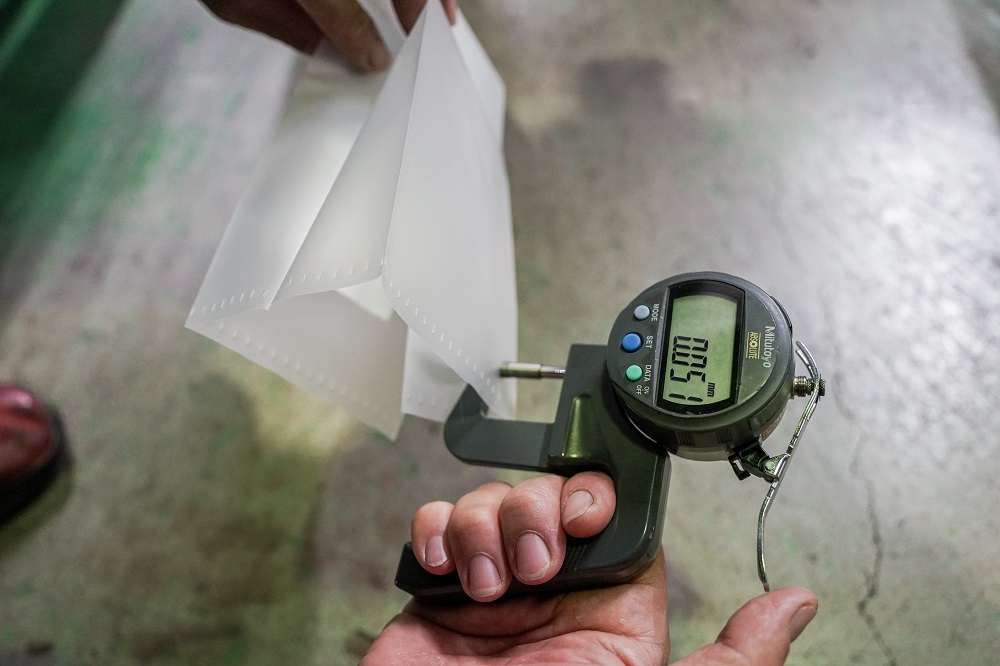 One of the eight measurement points for bag thickness.
One of the eight measurement points for bag thickness.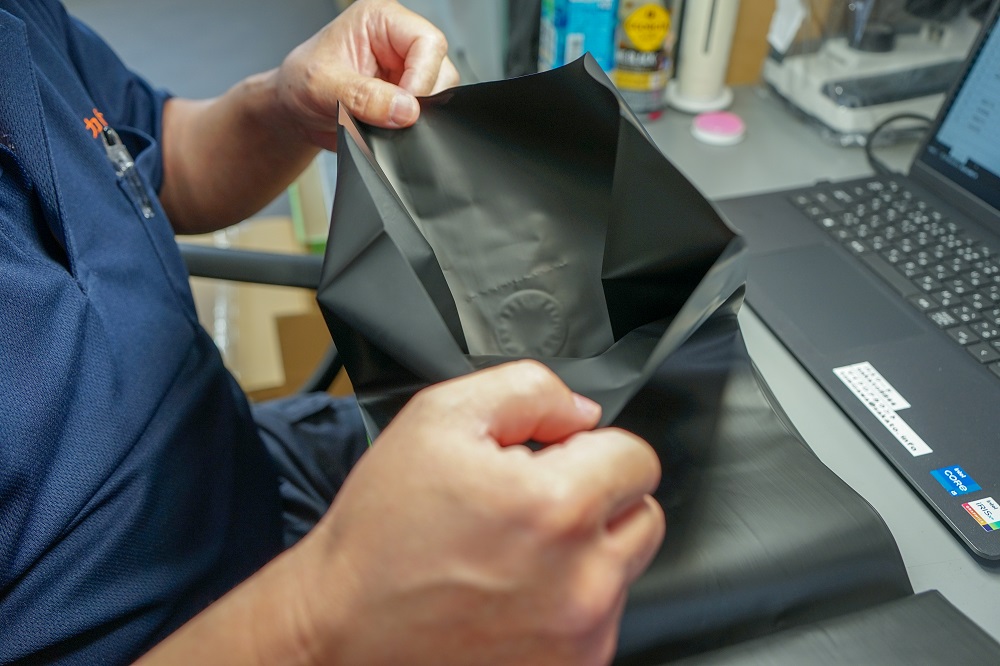 Inspecting the seal of the filter from inside the bag and the checing the edges.
Inspecting the seal of the filter from inside the bag and the checing the edges. A worker presses against an upside down cultivation bag filled with water to test the filter itself for leaks.
A worker presses against an upside down cultivation bag filled with water to test the filter itself for leaks.- Wrapping upSakato is a phenomenal partner, a business with a firm commitment to quality and a view of the long-term. Despite the fact that Sakato Sangyo, as a business, is working in plastic manufacturing, a difficult and specialized industry itself, you would be hard-pressed to find many people who know more about the mushroom business and are more familiar with the ins and outs of exotic mushroom farming, than Sakato’s leadership. Their all-rounded base has made them an indisputable partner, not just for us at SALAI International Japan, but for new exotic mushroom farming operations across the world.Reliability and stability are not meaningless buzzwords on a mushroom farm, where growers know that the smallest breakdown in the process can lead to total failure. Mushroom farms are complicated enough as it is, with those managing them already dizzy trying to keep track of all the moving parts. Bags shouldn’t be more thing for them to worry about, and what’s more, growers have to be able to expect their bags to perform precisely.We look forward to continuing to work to develop the exotic mushroom business as an exciting and high-yield agriculture business that scales well and can fit widely into existing agricultural networks around the world. For that, reliable bags, reliable machinery, and reliable information are key, and we aim to meet those needs in a convenient one-stop location. This is embodied in our motto here at SALAI International Japan: Everything you need for exotic mushroom cultivation.
.jpg)

